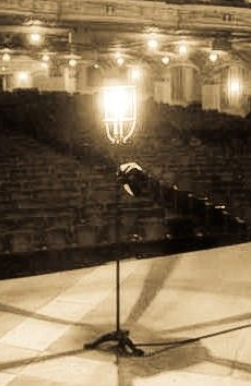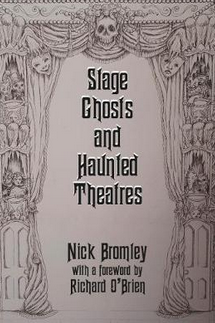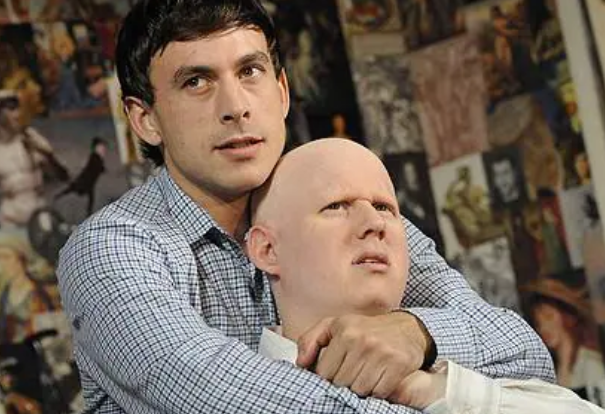Nothing in theatre is more evocative to me of how its a place steeped in tradition but also superstition that the ghost light, placed centerstage of an otherwise darkened stage after a performance every night, to provide a beacon in the darkness to guide people around the stage safely, and prevent anyone who enters the stage area from stumbling either into the orchestra pit or into the set.

That, at least, is its eminently practical use; but there are also claims that the tradition began in the days of gas-lit theatres, when dim gas lights were left burning to relieve pressure on the gas valves. And then there’s the superstition around the prevalence of theatre ghosts, with ghost lights provided, in one version of the reason for their existence, being to scare them away, or in an alternative one, to appease them, enabling them to perform onstage and prevent them for getting up to mischief to sabotage or disrupt a show. In the last year of theatre closure, they’ve also acquired another symbolic purpose, with some theatres using them as an indication that the theatres WILL re-open.
But just as Tinker Bell urges audiences during performances of Peter Pan to applaud if they believe in fairies and thereby restore her to life after she drinks poison, what does it take to believe in the actual existence of theatrical ghosts?
I’ve just found the answer, and it is reading Nick Bromley’s alternately gripping and chilling, yet always highly personal and personable trawl through British theatre history, called Stage Ghosts and Haunted Theatres (published by LNP Books, and available to order here).

It is informed by his long career as a company manager, working in theatres up and down the land, and meeting many of these ghosts along the way either himself, or talking to others who’ve encountered them.
I’ve known Nick for many years: he’s a stalwart company manager of the old school, at once all-knowing and discreet, who looks after every element of a show’s backstage life: they are the producer’s eyes and ears on the ground, but also the glue that holds a show and the company together. Nothing typically escapes their notice as they act as a bridge between the show and its management, who are typically located in offices at different premises, and to whom they file a show report for every performance that itemises any mishaps, misadventures or absences.
They are also frequently the calm in the storm of theatre production: no problem is too big for them to solve, no shoulder more welcoming to cry upon. My contact with Nick was usually around when I was set up to do interviews with cast members of shows he was in charge of; rather than coming down to make the introductions, the press agent usually simply asks Nick to stand in and do the honours, as he’s already on the premises, knows where the actor concerned is, and is trusted by them. So it starts everything off on the right note.
Anyway, all of that is by way of explaining why I intrinsically trust him; and therefore believe that nothing in this wonderfully observed and thoroughly researched book is made up. Much of it is first-hand, based on his own experiences.
Take the chapter on the Harold Pinter Theatre, originally the Royal Comedy Theatre and then the Comedy Theatre, until it was renamed the Pinter in 2011. Nick notes that “Harold’s shade, though hopefully pleased, does not appear to have returned to haunt the scene of his past triumphs. I can disclose however that there is the distinct possibility that another dead playwright did so when I was working there.”

He is referring to the serially-jinxed production of Prick Up Your Ears, a new play about the relationship between Joe Orton and Kenneth Halliwell (played by Chris New and Matt Lucas respectively, pictured above), the latter being the playwright’s partner who ended up murdering him, with Gwen Taylor as the landlady at their Islington home where the murder and suicide took place.
The chapter is full of resonant detail, like this one:
“Violent death is seldom silent and I well remember Daniel Kramer, our director, at the end of one rehearsal, skilfully creating the sound effects for the skull racking, brain splattering moment with the aid of a busy claw hammer and a pliant water melon.”
But he also chronicles a series of mishaps that started occurring on the show’s short pre-London tour, which in Salford, for instance, saw Chris New sent to A&E to checked up on after “a misjudged hammer blow”.
Then on the show’s opening night in the West End, the theatre’s chief electrician found himself heading to A&E, too, after being blown off his feet by an electric shock earlier that afternoon while checking a lamp’s position.
“An hour or so later at around 6.15pm, just before the house was to be opened, a corner of the cornice which ran along the top of the walls of the set fell with a crash to the floor, just missing the production manager Gary Beestone and myself as we stood on stage waiting for the front of house manager to arrive. Jumping back into action, we held the house and screwed the cornice back into position. Job done, we dropped the curtain, opened the auditorium doors and nervously rechecked all the props and furniture as the first nighters jostled and scrambled to their seats.”
The onstage and offstage dramas continued that night, including a minor series of malfunctions he catalogues that includes “the front door handle falling off, the communication cans between the electrics board operator and the prompt corner failing, the typewriter mic feeding back and the reel-to-reel tape recorder emitting strange noises.” (Nick is so thorough in enumerating them, it makes me think that I’m sure his nightly show reports are a real treat; I bet these notes came from them, unless he is has an astounding recall for detail after the event).
Anyway, at the end of that first night performance, as he and the aforementioned production manager Gary sat in the company office listening to it via the tannoy speaker, he writes,
“The very last thing we would hear would be the recorded sound of the hammer blows crunching into Joes’ skull. Would the sound effect fail? As the first blow came over the speaker our fists punched upwards in triumph, only to suddenly stop in mid-air. For, in perfect synchronisation with each hammer blow, we witnessed the office wash basin shake violently as something else gurgled in time in the waste pipe below it. At last the hammer stopped its carnage, and instantaneously the basin stilled and the pipe fell silent. Needless to say, we backed up, open mouthed, out of the office towards the stage and curtain calls.”
There are two sequels to his story, of Joe Orton’s possible haunting of this theatre, but he only mentions one. The first is one he is too discreet to report, as it concerns the unfortunate circumstances in which the run was curtailed: soon after the first night, Matt Lucas’s former husband took his own life, and Matt left the show.
The second, however, is when he was back at the theatre a few years later, this time as company manager of a revival of Alan Ayckbourn’s Absent Friends. Towards the end of the run both he and the show’s DSM were employed next to work next on a revival of Orton’s What the Butler Saw that was heading to the Vaudeville.
Doing some homework ahead of the job, he scoured the second-hand bookshops of Charing Cross Road to see if he could find a copy of the play he was doing next, and found a copy of Orton’s complete works for £1.99, illustrated by a picture of Orton wearing a pair of “bulging white swimming trunks and a provocative smirk.”
He then writes,
“Not wishing to have the photo staring at me all night long, I put the book front cover up on the desk and went in search of a sandwich. On my return I found that someone had apparently turned the book over for Joe was there again face up. I flipped him over, but, by the interval of the evening show, his face had reappeared twice more.” This happened again during the second act, too. When Nick came to file that night’s show report, DSM Kirsty admitted that it was she who had turned the book over the first time, and the ASM next admitted that she had, too.
And Nick completes the story:
“How many times?, I asked. Only once, she replied. The report was finished but I paused before saving it to file. That still doesn’t account for the other two times, I said. It’s got to be bloody Joe, and hit the keyboard to save the report. The screen went suddenly and totally blank. Something was wrong. I clicked the keyboard again in frustration and a message appeared. We all stared at it in disbelief but there it was before our very eyes. It simply read: it wasn’t me.”
This particular chapter, of course, is especially gripping, for all the personal detail he is able to provide.
Elsewhere, however, he has great first-hand sources for many of his other stories, ranging from Sir Patrick Stewart, Forbes Masson and Joseph Millson, each recalling seeing the ghost(s) they’d witnessed at the Theatre Royal, Haymarket (the first on Waiting for Godot, the next two on Mr Foote’s Other Leg), to long-time Old Vic stage door keeper Ned Seago and actors Robert Sheehan and Jonathan Coy, all reporting the same story of the smell of cooking of sausages (which wasn’t, in fact, taking place at the time) at that theatre.
There are detailed chapters on hauntings at some 20 more London theatres in addition to the three mentioned above, as well as shorter stories from five more, as well as the Garrick Club; but Nick doesn’t confine his attentions solely to the capital. There are also extended entries for 17 regional theatres, from Bath and Bristol to Wolverhampton, and shorter ‘interval’ stories from six more, plus a hotel in Totnes.
Like all good company managers, Nick has done his homework thoroughly; but like many theatrical folk, he also likes to spin a good yarn. This book combines the conspiratorial pleasures of late night theatrical bar and fireside chats with proper first-hand accounts to back them up. I’d sooner spend an evening with Nick now than a night in one of these theatres by myself.
